THE GEOGRAPHY OF THE MOON
Professor Phillips, Dr. Lee, and Mr. Birt, have made us familiar with the geography of the moon. The have measured the vase plains, surveyed the chains of mountains, named every isolated peak, noted the craters, the valleys, terraces, rocky ridges, and other variations on its surface, as minutely as though the body were one of our colonies. Enormous plains, one of which they have computed to measure 61 German miles long, stretch away till they are fringed with rocky promontories or checked by precipitous mountain ranges. Craters abound in every direction. Some of the smaller mountains resemble cups set in saucers; others consist of dispersed cups. In the centre of some of the larger mountains, as in those named Copernicus and Gassendi, are masses of broken rocky country, about 6,000 feet high, having buttresses which die away in collateral ridges. In another large mountain, named Theophilus, the centre is formed of a conical mass of rocks, 15 miles in diameter, full of enormous clefts, which are bright and shining. The whole aspect of the moon is expressive of volcanic action on a grander scale than that which has prevailed on our globe. A continental savant, Benzenberg, argues that shooting stars migrate from the moon.
